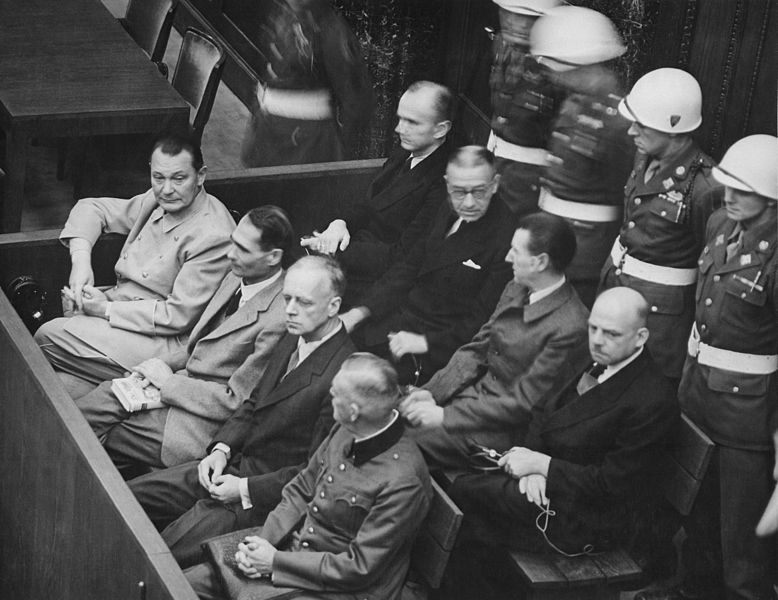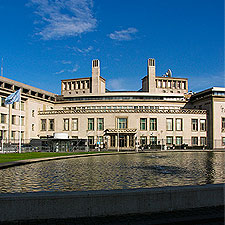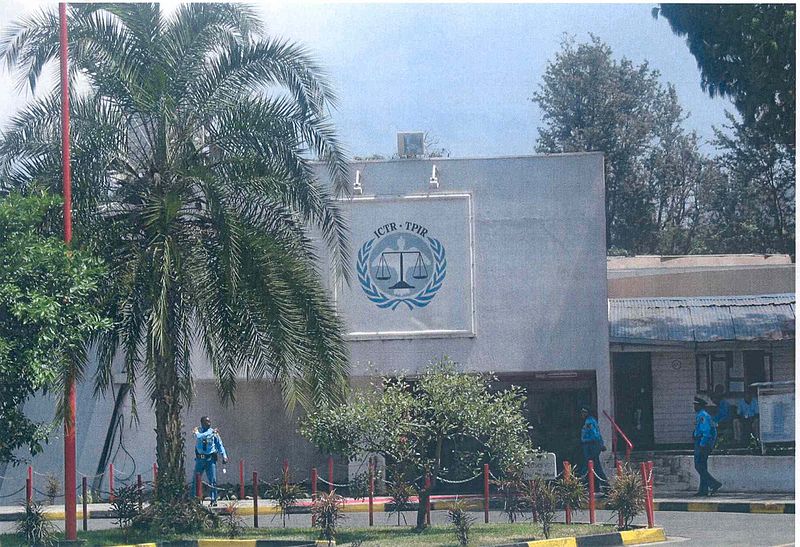International
back to topIMT Nuremberg

(Source picture: Wikipedia)
The International Military Tribunal (IMT) Nuremberg started on 20 November 1945, six and a half months after the German surrender. The US, UK, Soviet Union and France (Allied Countries) established a tribunal by means of a multilateral treaty, in order to try political, military, diplomatic and economic leaders of Nazi Germany. The Nazi top consisting of Hitler, Himmler and Goebbels, did not stand trial because they committed suicide. They were also not tried posthumously. Instead, 24 suspects were selected, of which 21 people appeared in court. Also Nazi organizations were indicted. Concerning the law applicable at the IMT, this was a mix of the systems of common and civil law. This included the following crimes: crimes against peace, war crimes, crimes against humanity and conspiracy. The Allied Countries supplied one judge and one prosecutor for the trials. The trials revealed the terrible stories of the Holocaust and other horrors of the war. On 1 October 1946 the judges gave their verdict. This entailed 12 death sentences, three sentences of life imprisonment, four sentences to imprisonment of 10-20 years and three acquittals. For more information on the defendants, see here. Finally, the IMT also declared four organizations to be criminal, namely the Leadership Corps of the Nazi Party, the SS, the SD and the Gestapo. Retrospectively, we can conclude that the IMT Nuremberg laid an important foundation for today’s international criminal justice system as the first international criminal tribunal. For more information on the Nuremberg trials, see here and here.
back to topIMT Tokyo

(Source picture: Wikipedia)
The International Military Tribunal for the Far East (IMTFE), Tokyo Trials, or Tokyo War Crimes Tribunal, was established by an executive decree of General Douglas MacArthur, Supreme Commander of the Allied Countries in Japan, who acted under US command. This decision was grounded in an agreement between China, US and UK to punish Japanese leadership. The IMTFE started on 29 April 1946, trying the leadership of the Empire of Japan for three categories of war crimes committed during World War II. The Prosecutors arrived from 11 Allied Countries, of which the Chief Prosecutor came from the US. In fact, the US was the dominant factor behind the Tribunal. The three categories of war crimes were the following. ‘A’ crimes referred to conspiracy to start and wage war, ‘B’ crimes entailed “conventional” atrocities or crimes against humanity, and ‘C’ crimes involved planning, ordering, authorizing or failing to prevent crimes. For ‘A’ crimes 28 leaders were indicted, of which nine civilian and 19 military. Of this group seven people were sentenced to death and 16 to life imprisonment. Also 5700 Japanese people were indicted for ‘B’ and ‘C’ crimes. As a result of the Tokyo Trials, war crimes in China were revealed, including the Nanking Massacre and the unconventional narcotics and bacteriological warfare. In 1947 and 1948, 50 suspects were released. The Emperor and his family were never indicted. The IMTFE was operational for two and a half years. On 12 November 1948, the IMTFE adjourned. For more information on the IMTFE, see here.
back to topInternational Criminal Tribunal for the former Yugoslavia (ICTY)

(Photo provided courtesy of the ICTY)
The International Tribunal for the Prosecution of Persons Responsible for Serious Violations of International Humanitarian Law Committed in the Territory of the Former Yugoslavia since 1991, more commonly referred to as the International Criminal Tribunal for the former Yugoslavia or ICTY, is a body of the United Nations established to prosecute serious crimes committed during the wars in the former Yugoslavia, and to try their perpetrators. The tribunal is an ad hoc court which is located in The Hague, the Netherlands.
The tribunal was established by Resolution 827 of the United Nations Security Council, which was passed on 25 May 1993. It has jurisdiction over four clusters of crimes committed on the territory of the former Yugoslavia since 1991: grave breaches of the Geneva Conventions, violations of the laws and customs of war, genocide and crimes against humanity. The maximum sentence it can impose is life imprisonment. Various countries have signed agreements with the UN to carry out custodial sentences.
The United Nations Security Council, in Security Council Resolution 1966 of 22 December 2010, called upon the Tribunal to finish its work by 31 December 2014 to prepare for its closure and transfer of its responsibilities to the UN Mechanism for International Criminal Tribunals (MICT) which began functioning for the ICTY branch on 1 July 2013. The ICTY will conduct and complete all outstanding first instance trials, including those of Radovan Karadzic, Ratko Mladic and Goran Hadzic. The ICTY will also conduct and complete all appeal proceedings for which the notice of appeal against the judgement or sentence is filed before 1 July 2013. Any appeals for which notice is filed after that date will be handled, not by the ICTY, but by the MICT.
back to topInternational Criminal Tribunal for Rwanda (ICTR)

(Source picture: Wikipedia)
The International Criminal Tribunal for Rwanda (ICTR) is an international court established on 8 November 1994 by the United Nations Security Council in Resolution 955 in order to prosecute people responsible for the Rwandan genocide and other serious violations of international humanitarian law in Rwanda, or by Rwandan citizens responsible for such crimes in nearby states, between 1 January and 31 December 1994.
In 1995 it became located in Arusha, Tanzania, under Resolution 977. In 1998 the operation of the tribunal was expanded in Resolution 1165. The tribunal has jurisdiction over genocide, crimes against humanity and war crimes, which are defined as violations of Common Article 3 and Additional Protocol II of the Geneva Conventions (dealing with war crimes committed during internal conflicts).
The United Nations Security Council also called upon this tribunal (cf. the ICTY above) to finish its work by 31 December 2014 to prepare for its closure and transfer of its responsibilities to the UN Mechanism for International Criminal Tribunals which began functioning for the ICTR branch on 1 July 2012.
back to topInternational Criminal Court (ICC)
.jpg)
(Source picture: © Schmidt hammer lassen architects)
The International Criminal Court (ICC), governed by the Rome Statute, is the first permanent, treaty based, international criminal court established to help end impunity for the perpetrators of the most serious crimes of concern to the international community (war crimes, crimes against humanity, genocide, crime of aggression). The ICC determines individual responsibility for these crimes.
The ICC is an independent international organisation, and is not part of the United Nations system. Its seat is at The Hague in the Netherlands. On 17 July 1998, the international community reached an historic milestone when 120 States adopted the Rome Statute, the legal basis for establishing the permanent International Criminal Court. The Rome Statute entered into force on 1 July 2002 after ratification by 60 countries. Currently 122 countries ratified the Statute.
The ICC is a court of last resort and based on the principle of complementarity; it will only act when states are unable (for instance when the legal system has collapsed) or unwilling (for instance when formal proceedings are undertaken solely to shield a person from criminal responsibility) to investigate or prosecute international crimes themselves. In addition, the ICC only tries those accused of the gravest crimes. Victims have the right to participate in all stages of the proceedings.
On 14 March 2012, the ICC delivered its first verdict, finding Lubanga Dyilo guilty of war crimes committed in Congo between 2002 and 2003. The Court concluded that he was responsible for conscripting and enlisting children under the age of 15 and using them to participate actively in hostilities.


